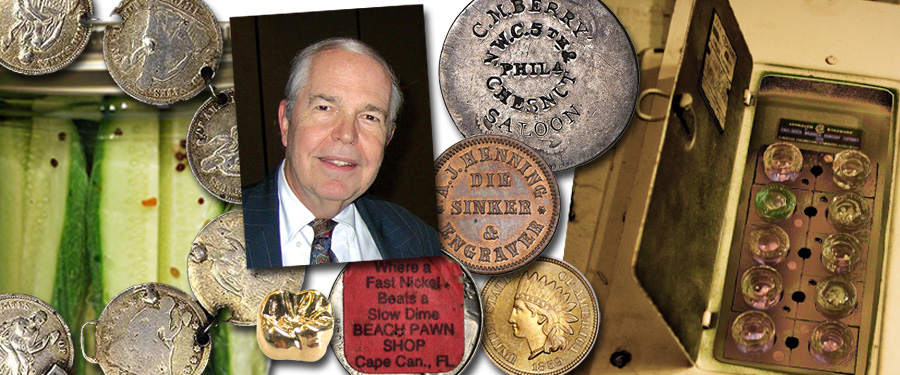
The following article by Robert K. Botsford in the October 1942 issue of The Numismatist offers some interesting uses for coins — none of which should be tried with collector coins!
Coins are the object of constant search by the coin collector. Certain coins are desired because of rarity, others to complete a series. To have and to hold as near a complete collection as possible is the prime factor. Yet, there exists another side to metallic currency, the utility side.
A study of utility uses to which coins may be subjected is interesting. The following list is only a beginning. There are many other utility uses for coins that are known to individuals. And, the author of this article will be pleased to learn of other uses for coins in order to expand this writing at some future date.
- Pennies on dead eyes. Pennies were placed on the eyes of dead persons, in the days gone by, to keep the eyelids closed. The coins ere not removed when the body was interred.
- Cent as substitute for fuse plug. A dangerous practice has grown up in recent years of placing a small bronze cent in the base of a fuse socket and then screwing back into place a fuse which has been blown out. The coin acts as a conductor but is burned to a crisp after a time.
- Copper cent as coloring matter. In pioneer days, the farmer’s wife would place a large copper cent in the barrel used to pickle cucumbers. The vinegar solution would dissolve the copper and give the pickles a beautiful green color. This was dangerous to the health and was very likely to poison the eater of the pickles.
- Ornamentation. Coins of all metals have been used for ornamentation by the peoples of all nations who have used coins. Coins of gold, of silver, of copper, or electrum have been converted into breast pins, tiepins, earrings, finger rings, coat lapel ornaments, necklaces, hair ornaments.
- Gold coin for tooth crown. Sailors often submitted a five-dollar gold piece to a dentist who, in turn, made the sailor a gold crown for his tooth out of the metal in the gold piece.
- Coin and can opener. Some types of tin cans have the tops pressed in place. A half dollar frequently is used to pry up this pressed-on top so that the contents of the can may be removed.
- Coins as advertisement. Jewelers often place a tray of old coins in the center of display window to attract attention to the items they have for sale. The old coins are not for sale in many instances. Their purpose is to interest the public and advertise the jeweler’s stock in trade. [QDB note: Not noted are the instances where coins bore actual advertisements, for example, counterstamped coins]
- Coin as screwdriver. A nickel or a dime is frequently used to tighten up a screw when no screwdriver is immediately available. These coins are also used to remove a coin in an emergency. They perform this duty in a very satisfactory manner.





